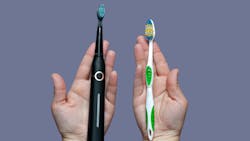Manual vs. electric toothbrush: What's the best choice?
Editor's note: Guest post excerpted from Nothing But the Tooth: An Insider's Guide to Dental Health, by Teresa Yang, DDS
The holidays are just around the corner, and your family has decided to focus on the practical this year. It’s almost certain you’ll receive an electric toothbrush. You’re not really a gadget-type person and you rather like your manual brush because you can change the color every couple months. Does anyone really need an electric toothbrush? What are the differences and advantages (or disadvantages) of manual vs. electric toothbrushes?
Is an electric brush better than a manual one?
A 2019 study aimed to answer that very question. The researchers followed almost 3,000 people for over 11 years. They found that sonic toothbrushes reduce the signs of periodontal disease and the number of teeth lost. Other studies have concluded that electric toothbrushes are more effective than manual ones at removing plaque, one of the main culprits of cavities and gum disease.
Also by Teresa Yang, DDS: When is a cavity really a cavity?
So, if you find an electric brush in your pile of gifts this year, by all means, keep it and use it. But not everyone needs an electric brush. For some, it’s an unnecessary expense, but an electric brush is highly recommended for others. These include:
- Children and teenagers
- Seniors
- Anyone with a physical disability such as a broken dominant arm or Parkinson’s disease
- Anyone with a cognitive disability like dementia or Down syndrome
- Anyone wearing braces
What to look for in an electric toothbrush
You don’t need anything fancy. Like cars, electric brushes are available with many options, for example different pressure settings. There’s also a push on manufacturers to introduce new and improved features every year. Some brushes are now “smart,” with Bluetooth capabilities. Brushing time can be recorded and tracked. Some apps provide coaching or encouragement, which may be beneficial for children. There are even apps that treat brushing like a game to incentivize children to brush.
The cost of the toothbrush is generally tied to the number of enhanced features. When picking a brush, consider which features you will definitely use. While some characteristics may sound appealing, they sometimes border on the gimmicky. For example, some brushes come with a UV light that claims to disinfect the brush between uses. Most experts agree that effective destruction of bacteria, viruses, and fungi with a UV light depends on a host of complicated factors and not as simple as it seems.
A basic brush with the following may serve you best:
- The right size: Sonic brushes come with either a small, round head or a rectangular one that more approximates a manual brush. Which fits in your mouth better?
- A timer: Almost all brushes are equipped with a two-minute timer that beeps every 30 seconds, signaling you to move from one quadrant to the next. Some brushes even automatically turn off after two minutes to prevent overbrushing.
- Replacement brush heads: Just like your manual toothbrush, brush heads should be changed every two to three months, or at the first sign of fraying bristles. Heads should also be changed after an illness such as a cold. Make sure you have replacement brush heads on hand, particularly if you’re purchasing a less expensive model that may be discontinued in the near future.
If you travel, consider the bulkiness of the brush. Some brushes come with travel cases. Since brushing techniques differ, it’s advisable not to switch between a manual and electric brush on a regular basis.
How to use your electric toothbrush
The biggest difference between an electric brush and a manual one is that you will hold the electric brush passively and guide it from tooth to tooth. Let the brush do the work for you. Resist the urge to apply additional hand pressure.
Helpful hint: At the beginning, consider holding your electric brush with your nondominant hand. Without that muscle memory, you may be less likely to apply undue force.
Electric brushes can be ticklish, and for a rare few, this may be intolerable. If you’re excessively ticklish elsewhere, consider experimenting with a loved one’s electric brush first. Insert a new brush head and give it a whirl.
What if you want to continue using your manual toothbrush?
Follow this simple rule: Brush softly with a soft-bristled brush. You can brush too hard and cause irreversible damage to your gums. Regardless of whether the bristles are nylon or plant based, stick with soft. Avoid boar bristles as they’re stiffer than nylon.
Again, you don’t need anything fancy; you can get a toothbrush for as little as two dollars. But if that stylish, Scandinavian toothbrush has caught your eye and you don’t mind paying five to 10 times more, go for it.
Eco-friendly toothbrushes
Bamboo toothbrushes seem to be all the rage, advertised with the following features:
- Biodegradable: Obviously wood will eventually degrade back into the earth, whereas plastic lasts forever in landfills.
- Eco-friendly: Regardless of the source, toothbrushes have to be mass produced in large-scale facilities. A wood product like bamboo must additionally be harvested and replenished to maintain its environmental impact.
- Antibacterial: Bamboo is naturally resistant to most bacteria, making it a potentially ideal candidate for cutting boards and the like. However, only the shaft of the brush is made from bamboo and the bristles are not antibacterial. Besides, our mouths contain a treasure trove of bacteria.
The bottom line: whether electric or manual, stick to basics
- Select a brush or brush head that’s not too big for your mouth. Ensure there’s enough room to maneuver the brush around
- Only buy a soft-bristled brush, and brush softly
- Change your brush or brush head every 2-3 months; also change it after you’ve been ill.
- Brush for a total of two minutes (30 seconds in each quadrant)
- The most important time to brush is at night before bed
- Brush your tongue
- Air dry your brush in between uses
- Do not share your toothbrush with others
Teresa Yang, DDS, has practiced dentistry in the Los Angeles area for more than thirty years. She has taught clinical dentistry and patient management at UCLA School of Dentistry, has written extensively on dental topics, and is a member of the Forbes Health Advisory Panel. She is the author of Nothing But the Tooth/An Insider’s Guide to Dental Health (Rowman & Littlefield, August 23, 2023). Learn more at teresayangdds.com.
About the Author

Teresa Yang, DDS
Teresa Yang, DDS, has practiced dentistry in the Los Angeles area for more than thirty years. She has taught clinical dentistry and patient management at UCLA School of Dentistry, has written extensively on dental topics, and is a member of the Forbes Health Advisory Panel. She is the author of Nothing But the Tooth/An Insider’s Guide to Dental Health (Rowman & Littlefield, August 23, 2023). Learn more at teresayangdds.com.
